
South by Kayak
Pushing through a field of brash ice, an intrepid New Zealand expedition closes in on the bottom of the world. Their goal: the Antarctic Circle. Their route: wherever wind, wave and ice permit a passage along the western shore of the Antarctic Peninsula. Their means: three fibreglass kayaks and a fair measure of grit.

Coleridge’s Kubla Khan would have been enthralled by the thousand hues and forms of ice in the white continent. Wind, gravity, sun and sea all play their part in creating icescapes as austere as they are beautiful.
The roar of surf on the cape was continuous. From where i stood i could see huge plumes of water being blasted skywards behind the headland. Those same waves curled around the cape to break on the granite flank we had been forced to land on. Further south, the coast was a vast, unchecked sweep of ice cliffs for as far as the eye could see.
I had made it ashore, but Marcus and Graham had yet to make their run. Marcus had allowed himself to be pushed too close to shore by the smaller swells and it was suddenly obvious he was going to be munched.
“Paddle, Marcus, paddle!” I shouted. A big wave broke behind him, the first of a set. With horror-movie fascination, I watched as he wrestled with the waves, somehow avoiding being surfed onto the rocks, then escaping to the safety of deeper water and the wallowing bergs. My heart was in my mouth; I reckoned his must have been beating on the deck of his kayak.
It was our 30th day on the Antarctic Peninsula, and this would be camp 20—if we could get ashore. Behind me, Cape Bellue climbed in rocky steps to the snow; avalanches thundered from ice cliffs crouching above the bay and grounded bergs listed like wrecked ships, the swells pounding into them, now and then to smash off a prow, or blast spume from holes in their sides. It was as dramatic a place as I could imagine.
I watched the next wave break foaming on to the granite teeth of the cove. Marcus chose his moment and ran his kayak up onto a ramp of rock and we pulled his boat clear. Then in came Graham, timing his run between swells. Another successful landing, another day closer to the polar circle.
We were nearing the end of a journey that had started three years before. Graham had been dreaming aloud on an email to Marcus and me. He pushed “Send” and the seed was sown: a dream to sea kayak the Antarctic Peninsula from its northern extremity to the polar circle.
Antarctica lays claim to a lot of “mosts.” It experiences the most intense cold, the most formidable winds and the most extreme accumulations of ice in the world. More than 30 million cubic kilometres of ice have accumulated to crush the continental rocks up to four vertical kilometres beneath. It lies at the end of the world; uncompromising, like a clenched fist from which an icy finger stabs north. This was the peninsula we hoped to paddle.

At the time we conceived the idea we had little experience of sea kayaking and scant knowledge of Antarctica. It was to be a long while after we announced publicly that we would do it that we laid our hands on any detailed maps of the coastline. We had a blank canvas to dream on, and somehow that inspired us and instilled confidence. We began to feel that the impossible was merely the improbable—and we could work with that. Even so, it took three years before we felt we had the minimum experience for the journey—or the cash.
Our plans took a huge step forward when Sir Peter Blake offered us a ride on Sea Master, his ocean research vessel, to get across the Drake Passage from Tierra del Fuego to Antarctica. However, it was a one-way ticket.
Our return lay unresolved for many weeks until a solution came in the form of a documentary film deal. We would shoot most of the footage and pay a third of the boat charter cost in exchange for a ride home. We didn’t really want the extra work, but it was the only way we could afford to get back from as far south as we claimed we would get.

In December 2000, we flew to Ushuaia, the world’s southernmost city, and close enough to the Antarctic for a phone call to be local. There was a lot to do: readying equipment, testing gear, learning the finer points of digital video cameras and how to shoot a documentary, organising a food cache for our pickup boat, Tooluk a, to drop for us on her way south; and the ongoing attempt to fill in the vast gaps in our knowledge of the coastline.
After a visit with the skipper of the yacht Golden Fleece, reputed to have enormous experience of the less travelled areas we sought information on, I had this to say in my diary:
Jerome spoke of the difficulty of what we wished to do, without saying it was impossible. He spoke of the density of the wind and the sea. He spoke of wind rivers, all-day katabatics, blower hays, deflection zones and big swells, not to mention the ice. I suddenly understood the extreme nature of what we had set ourselves and why it has not been attempted before. He asked of our experience for such a trip. It was difficult to answer directly.”
[Chapter break]
On January 14, Sea Master dropped us at Hope Bay. We stood by our kayaks amid a pile of gear and food and waved them good-bye. We were on our own at last, relying on our wits and our friendship, finally poised to launch into the waters we’d dreamed of.
Our first paddling day was a journey into the dangerous territory of sensory overload. We launched among grounded “bergy bits” into a bay teeming with penguins on their way home from the krilling fields. Within 10 minutes we encountered orca, and as we headed along the coast we experienced collapsing ice cliffs, strong currents, slush-ice from the accumulation of falling snow and patches of ice bits called brash. The burning questions we had had for the past two years were being answered—all at once.
The brash ice bubbled like battered fish in a frier, releasing air long trapped and compressed by glaciers. The water temperature, however, was close to freezing.
“Hey, you guys, take a look at that!” The last part of the directive was lost in a roar as a berg towering four storeys out of the water tipped over without warning. Green water poured from its flanks and an expanding ring of ice debris headed in our direction. We acquired a new respect for bergs.
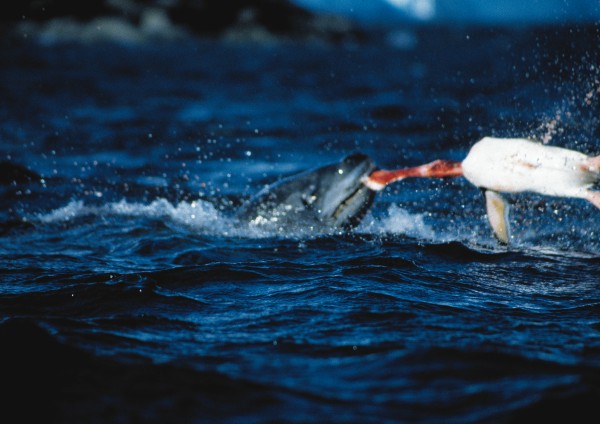
A strong wind sprang up behind us, bringing snow. Visibility worsened. Our plan was to make Gourdin Island, 30 km from our starting point. There was nowhere in between to camp, so we had no choice but to keep going.
At 11:30 P.M., exhausted from paddling heavy kayaks in mounting seas, we pushed our way through brash ice into a small cove on the lee of the island. Ashore at last. But the day wasn’t ever over till the tent was pitched and protected, the kayaks tied down and enough brash melted to cook a meal with.
Our first radio sched was a tense one. “Any vessel listening, any vessel listening, this is Kiwi kayakers. Please respond.” We could hear ships communicating with each other, but it seemed that no one could hear us. We worried that our set was at fault. Finally Tooluka made contact. It was a vital connection.
The skipper hadn’t been able to put the cache where we wanted because of ice, but he’d managed to plant it 15 kin further south, at Sprightly Island. He also warned that the brash to the south of us was a kilometre out to sea in places. We would have our work cut out for us.
Overnight, the wind crammed our cove with ice, forcing us to stay put. Fortunately, by the following day the ice had dissipated enough for us to force a path through it, and the wind had dropped. We packed up to go, but the wind picked up again. We unpacked. When the wind spoke, we listened.
Another day of enforced rest, but no shortage of things to see. We had landed between colonies of adelie and chinstrap penguins. Weddell, elephant and fur seals basked a mere stone’s throw from our camp. There were bold skua gulls, cheeky sheath bills, and snow petrels, pretty beyond compare.
[chapter break]
More than 2300 cubic kilometres of ice is calved from the Antarctic ice sheet each year, resulting in some 300,000 icebergs free to roam the Southern Ocean. We watched one such berg driving purposefully into the wind, ploughing through waves like a barge. It was driven by water, not wind, by sea currents pushing its great keel deep beneath the heaving sea. There were strange unseen forces at work in this place.
We woke on the third morning to wind from the south, but it was light enough to paddle into. We struck camp, launched through a porridgy mix of ice blocks and broke out into open water.

Our maps offered little encouragement regarding landings for the next 200 km or so. Each day we set out, destination unknown, with the faith of the blind that we would find a place to land. A diary excerpt describes a typical day:
Our first hope was a penguin colony that proved too steep to land at. We fixed the distant Cape Marescot in our sights. It reared out of the water without so much as a place to rest. We rolled the dice again and with tired arms struck out for the Duparc Rocks that lay several kms south and out to sea. Things were getting desperate. When we got there the swell surged up the flanks of–the small islands, and we paddled from one to the next, ever hopeful of a break. The last offered a gut that sucked and spat at the sea. It was a possibility and we stared at it for a time but weren’t convinced. Circling the islet produced nothing better: “This is as good as it gets, team,” said Graham. It wasn’t very good. He timed his run to perfection between swells, and lurched from the boat on wobbly legs, hauling his boat above the waves before it got munched. Marcus and I followed in the next lull. We had to lift the boats three metres and secure them above the surging sea. This was only possible with three people lifting.”
Our tent was perched on snow between surge holes that in a bigger sea would blow spray. It was a dramatic location with a clear view up the coast to the sinister-looking Cape Roquemarel. Twin crescents of snow, side by side, bestowed the black cliff with eyes that seemed to fix us with their gaze. It was as if the south coast had assumed a face—and it didn’t look a very friendly one.
One of our longest days was on this section. We had been several days on the go, intent on getting as far south as we could before the weather pinned us down again. We set out across Bone Bay, the first of the large bays we had to cross. It was tense paddling, our eyes fixed on the farther shore, with nervous glances toward the mountains. For two and a half hours we held our breaths, hoping the mountains would hold theirs, too, but just as we started to relax and feel we had it in the bag the water changed colour. A darker shade of blue swept toward us, flecked with white. We went to full steam, paddling hard to make the shelter of a point. We made it to a cove choked with beautiful blue bergs and surrounded by hanging ice cliffs. Rock bluffs soared 200 in sheer out of the water, and there was no place to land.
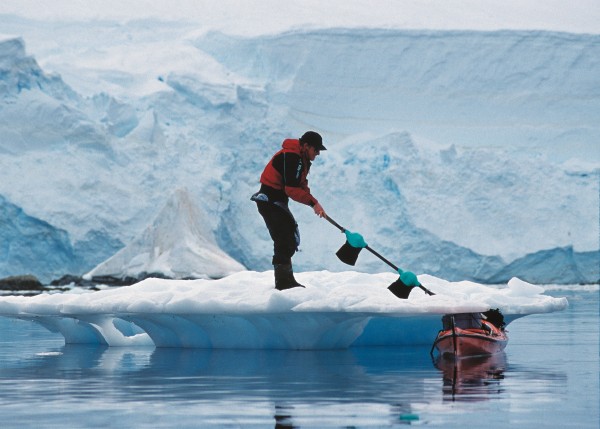
I wanted to stop. An old shoulder injury was nagging with each stroke, so we threaded a line through the bergs south to a headland we hoped would afford a shelter. A landing through surf on to a narrow beach of ice blocks offered a rest, but it was no place to stay long. Under an overhang of unstable-looking rock Marcus brewed the billy while I wolfed down Voltarin. Patched up and with spirits lifted, we launched into brash ice and continued south.
Our hopes of a landing at Cape Kjellman, 5 km distant, were dashed with the size of the swell running up the rocks. To continue was a grim prospect. Charcot Bay lay ahead—four hours of exposure to the violent offshore winds for which it is renowned. But the winds had died to a whisper, and other options weren’t leaping out at us.
Four hours is a long time to contemplate the speed with which the wind had appeared only hours before. Such crossings feel like they have an element of Russian roulette about them.
Click went the hammer. The wind stayed calm for the crossing, but Kater Rocks, on the far side, didn’t offer a landing either. More Voltarin.
We headed around the point, and suddenly Marcus was in trouble. A rogue wave hit him as he shortcut a shoal, and caught him sideways, surfing him towards the black wall of the cape. He managed to stay upright, pull himself clear and, minus his ice axe, stripped by the wave from his deck, paddle out before the next set was upon him. It was a close call.
Ahead were the Jaquinot Rocks, where we had been assured there were landings. What we found instead was a series of stone pillars rising sheer out of the sea. We had yet to encounter any islands less able to be landed on! It was getting funnier by the minute.
A further half hour and we could see a breaking shoreline in the distance which offered salvation. We landed through surf and lifted our boats clear. After 65 km and 14 long hours paddling, we could at last pitch a tent and sleep the sleep of the dead.

The snow we camped on that night was on a raised bench of land that we shared with fur seals and Weddells hauled out to warm up on the snow. One end of the flat area bordered a cove, above which clung cliffs of ice. Every so often we would hear a roar as a spectacular fall of snow and ice plunged into the bay.
The weather had turned uncharacteristically warm, and avalanches became more frequent. At one point we sensed something dramatic was about to happen, and, like moths drawn to a flame, the three of us stood on the raised beach above the cove, cameras at the ready. It was perfect timing. A colossal wall of ice 10 storeys tall let go. It plummeted towards the bay with a deafening roar and smashed into it like a fist.
My first thought was of one of those amazing photographs of a droplet of milk, frozen in mid splash; an instant later it was obvious we were going to get creamed. I could hear Graham and Marcus yelling, but I was already running for my life through soft snow. It was like one of those bad dreams where your legs feel like lead and you’re being chased by something that’s out to get you.
My boot stuck and stayed behind as I flailed my way uphill. Behind me, the wall of water rolled over the three-metre berm as if it wasn’t there and swept up the slope. I turned to see my boot surfing up behind me, and snatched it from the water before the wave receded. It was that close, and wet socks were a small price to pay for the lesson. The bay was soon filled by a fan of brash spreading almost as fast as we could paddle. Had we camped on the other side of the flat our tent would have been heading out to sea with it. It was a tense night, listening to the cracks and booms as the cliffs continued to tumble.
[Chapter break]
It was snowing when we woke, but the wind was from the nor’east, behind us. We decided to go for it. I have a lasting image from the day: Graham passing a giant green berg, clear as bottle glass, the back of his jacket plastered white, and snow dancing in circles in a wind eddy off the berg.
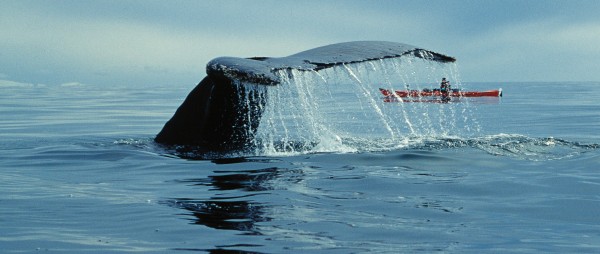
At Cape Andreas the wind got worse, accelerating around the cape and creating downblasts beneath the ice cliffs. We had been going 10 hours and considered a possible tent site, even though it was compromised by ice cliffs. A tonne of ice shook itself free and crashed on to the beach. We carried on.
Our reward for the long hours of paddling was a small island in a sheltered cove connected to the cape by a beach of boulders. A dense patch of brash ice lay between the beach and us. Like flies in ointment, we clawed our way through the cloying brash, past cliffs fat with ice.
The weather enforced a rest day—a good opportunity for tendons and muscles to mend, and hands as well. Mine seemed to have faired OK, but Marcus’s were blistered and Graham had lost feeling in a finger. Fifty-kilometre days come with a price in boats as heavy as ours were.
Two days later we made for our cache. We were two hours away when a distant line of white hinted at trouble ahead. Five kilometres from Sprightly Island we came up against a wall of bergs frozen in a sea of brash. It seemed to stretch forever each side of us.

I lost the round of “roshambo” and was the one elected to stand up in the kayak and seek a way ahead. With Graham and Marcus holding me steady I swept the horizon with binoculars, only to find that the ice seemed to stretch forever in both directions. We took a punt on intuition and paddled south along the edge of ice, and it eventually thinned enough for us to sneak back towards Sprightly.
Tholulea had given us GPS coordinates for the cache and we soon saw our crate, waiting for us at the head of a surging gut. We rode up and down on the swell, staring beyond the breakers at our food. We decided it could wait a while longer. The landing was too dicey, and we retreated to the shelter of the other side of the island to have lunch and pluck up courage. An hour later, we picked our moments and ran the gut. Practice makes perfect, and we beached on to boulders with barely a scratch to our hulls.
A patch of snow, green with Antarctic algae, offered a tent site. We restocked our kayaks and departed in the morning, the boats desperately heavy-90 kg, we estimated—but the worst of the coast behind us for a while.
There were no ordinary days on this trip. The feature for the next one was whales. We were probing through thin brash into Hughes Bay when we heard a distant spout, then another, then some more. The bay was being worked by the masters of krill trawling, humpback whales. Soon a trio checked us out, surfacing mere metres from our kayaks.
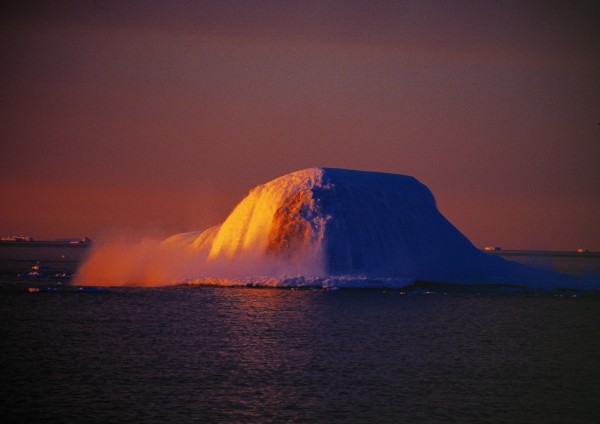
It was a magical crossing, zigzagging from one pod of whales to the next on our way across. In the distance, a black hulk lay motionless, and except for an occasional spout appeared lifeless. “A sleeping whale,” I exclaimed with unsuppressed glee and sped towards it. It was like a smooth, black reef, the water lapping at it, and we sat alongside in our boats, mesmerised by the size of the behemoth. Its breath smelled fetid and fishy, purged in a steaming plume that shone golden against the sun. We watched it for five or ten minutes before it awoke and, with a wave of its tail, headed for the depths.
Graham Passage offered a shortcut behind Bluff Island—a stunning corridor through the mountains and a fitting entrance to what lay beyond. The mountains were steeper here, the plateau higher, and enormous glaciers poured into the sea.
[Chapter break]
We had broken the back of the first part. Soon we would reach the relative sanctuary of the middle section, where landings were more common and human contact was guaranteed: the “tour zone.” In the following two weeks we visited two bases, a ship, two yachts and Antarctica’s only Royal Post Office. We had made good progress and could afford to be more relaxed in this section, enjoying the wildlife, the scenery and the encounters with people.
Antarctica is a continent, not a country. It exists as a cultural void, but it is far from uninhabited. Many nations lay claim to it, and people from all walks of life are fascinated by it. A lucky few find the means to get there—drawn not just to the enormity of the place but to its simplicity, to the unsullied grandeur it promises in a world that seems increasingly grubby by comparison. There is a feeling of kinship among those who have ventured this far south, and, without exception, we experienced warmth and generosity from the “Antarcticans” we came across. Contact with these people enabled us to get messages back to New Zealand—the only way folks back home could find out if we were OK.
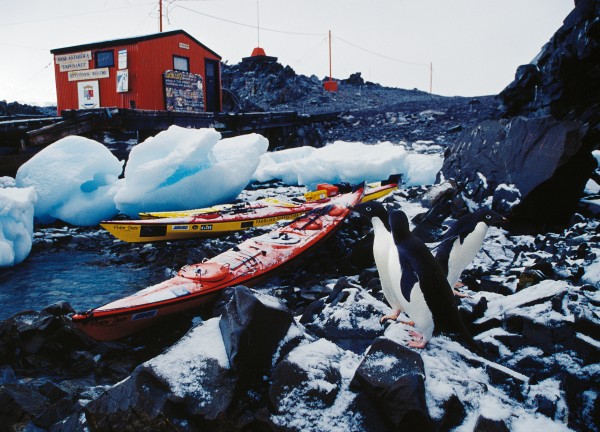
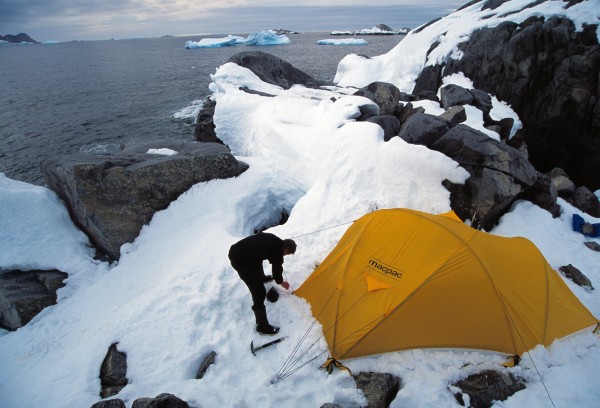
In the south the coast was characterised by deep bays and fiords, with few, if any, landings, mountain chains that rose sheer from the sea and giant glaciers running between the two. Our plan was to island-hop, thereby avoiding the worst of the katabatic winds that descend from these mountains and sweep out to sea.
At times we found ourselves paddling by compass in white-out conditions, with snow falling in fluffy clumps. On other days we were in sunshine, far from land, adrift with the bergs. Some island,, offered little more than a spit of stony beach, barely dry between tides, but occasionally we were able to make landfall on the mainland.
The line between land and sea is blurred by ice, in which the two find common ground. It is a zone in constant flux, its heartbeat the thud and shudder of glaciers, its voice the crack of cleaved ice and the skua’s cry. It speaks of life and death and promises nothing but the endless cycle of freeze and thaw. The scenes we witnessed we will never forget: evenings of mirror calm, the icebergs lit up like lumps of gold and the brash ice being drawn from the bay as though a giant hand were pulling on a corner of the ocean; hulking ice cliffs barking and groaning and shaking loose scales of ice as the last light of day paints the glaciers pink.
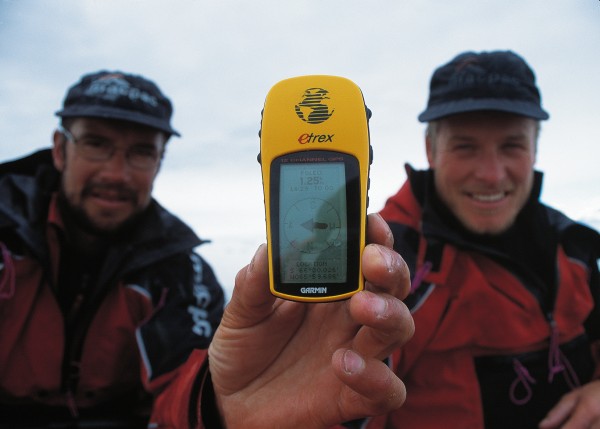
The polar circle—an imaginary line circumscribing the globe at 66° 30′ S—lay tantalisingly close to us now, just an hour or so south of us.
“In two days we’ll be out of food,” Marcus reminded us. “If Tooluka is within two days of us we should have radio contact by now.”
“Going further south means we’ll almost certainly lose contact with Port Lockroy,” Graham added. From where we were, on a good night we could just get a message through to them.
To go or to stay? As we were agonising over the implications of each option we were interrupted by the radio. “Explorer, Expl . . . Yormolova.” We tuned in to the broken conversation between the two vessels and learned that the Explorer would be passing Adelaide Island late the following day.
“Might be a ride north.” Graham was thinking aloud and staring south at … nothing. A plan was forming. “Explorer, Explorer. Kiwi kayakers. How copy?” We all stared at the radio, willing it to answer. The static cracked and spat like brash ice in a billy. We leaned closer. A voice leaped from the radio “Kiwi kayakers, Kiwi kayakers. This is Kim. Copy you 5 out of 10, over.” In five minutes a ride north had been offered if we wanted it. The hitch was that we were 90 km away from where they would pass. Could we get there in time?
We had just had dinner and were contemplating bed. A quick discussion ensued. We did some sums and realised we had no time to spare. As well as the distance to be overcome, Lallemand Fiord lay to the south of us. It scared us. It was a “blower,” a place where it looked as if a giant fist had punched a hole into the very lungs of the land, the perfect drain for those vast expanses of heavy cold air. It lay like a sleeping dragon gaping at the open sea. To us it defined the end of the peninsula, more than a latitudinal boundary did. It was the final physical barrier to be overcome. Explorer could meet us in Hanusse Bay, south of the dragon. Would it stir and put paid to us with a blast of its icy breath? We decided it was the best option.
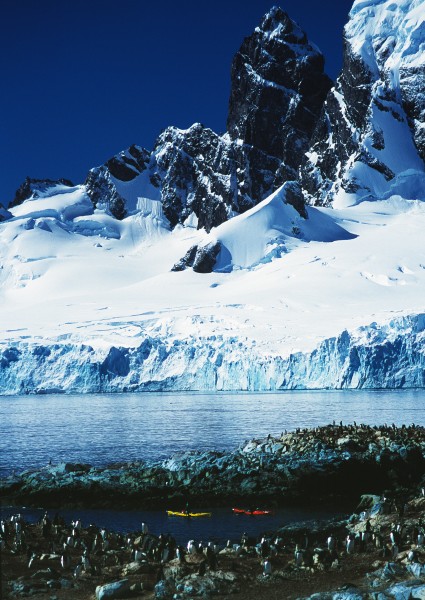
We needed to leave immediately and paddle through the night if we were to make the pick-up. There was suddenly an air of urgency and excitement, tinged with the apprehension of knowing we were setting ourselves up for an epic paddling leg.
It was 10.15 when we left the sanctuary of the island. The sky was on fire and bergs were silhouetted against the horizon like spilt chess pieces.
Marcus had the GPS, and after an hour he called a halt. We were almost at the polar circle. Together we coasted the last few metres over the invisible line we had come so far south for. It was like any other piece of ocean, far from the security of shelter, and our celebration was short before we bent to our paddles again in the growing darkness.
Graham has an eye condition rendering him sightless in the half-light, and half an hour later he was as good as blind. A vague silhouette of black paddle against almost black sky kept him on track, along with our voices.
“Jonesy, I’ve lost you.”
“Over here. Go hard left.” “What?”
“HARD LEFT!”
Kathunk!
“Damn. What was that?”
“Berg. Over this way.”
We continued in this way beneath old blue stars and a sickle moon, trying to second-guess the brash field, pulling ourselves through black water that winked with phosphorescence.
As the light seeped back into the world, there was the distant thunder of artillery—the glaciers were waking up. Ice was building up on the kayaks with each splash and stroke as we wove our way through a maze of bergs and ploughed through soup-like patches of semi-frozen sea. The further south we pushed the denser the ice field became. Up ahead, a jumble of bergs hunched shoulder to shoulder. We had run out of leads in an icefield without end. The maze was winning. There was nothing for it but to backtrack and head out to sea to find a way south.
- The yacht Tooluka ferried the expedition back to South America, en route losing sails in gales, running aground, blowing a drive, being becalmed and then briefly impounded by the Chilean navy. All events which cut little ice with this crusty elephant seal.
An hour later we were slicing south again. The ice was more open and the dawn air razor sharp in our lungs. Our boats were heavy with ice-glaze which we chipped at with our paddles. The views were breathtaking. Like a great maw, Lallemand Fiord stretched back into the mountains, breathing easy for now, and we pointed our bows to the farther shore and settled in to the faster stroke rate that we save for such crossings.
The hours passed; the dragon dozed. Nervous glances to the mountains. I checked the barometer. No change. Another look at the mountains. Was that wisp of cloud forming a cap over that peak? Was the breeze strengthening? I was suddenly sure it was stronger. An icicle of fear ran down my spine.
“Is that a line of white-caps?”
No one answered. Of course it was. In a short time the wind had increased to raise a sea, and with ice cliffs approaching on our lee the danger of our present course was obvious. We turned and ran before it for the shelter of bergs on the north side of an island, and eventually found a cove to hide in after 16 long hours in the saddle.
Three hours later, we made contact with Explorer, on her way north. The katabatic had blown itself out, and after another hour’s paddling we met her in the deep water of Hanusse Bay. Our boats were hoisted aboard and we entered a world of water on tap, showers on call, five-course meals and people that didn’t smell of penguin guano. It was a surreal experience to be plucked from the wildness and the dangers of one reality and deposited into the luxury and security of another. We adapted fast.
Explorer dropped us at Port Lockroy to await the arrival of the Tooluka, which turned up three days later, having been delayed by storms in the Drake Passage and the rescue of an Australian mountaineer, avalanched into a crevasse on the peninsula. We spent five days filming as we worked our way north along the peninsula. We found ourselves fascinated anew by the coastline we had kayaked along. Had we reconnoitred it, we decided, we probably would not have attempted the journey. The impression is one of too few landings that are too exposed to the weather.
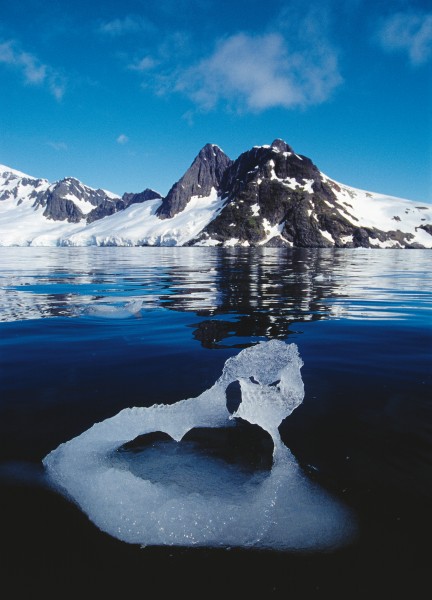
But we had done it. We had lived on the ragged edge of the land, between relentless ocean and implacable ice. Like the twilight hour between darkness and day, that boundary lacked the harshness of either, and yet was somehow more than both—a zone of unforgettable beauty and dramatic change. To live out of a kayak and journey along this wonderland was to experience life stripped bare, like a berg pared back by the elements. What remains is the essential core of living: friendship, endeavour and the beating heart of the wilds. Each dawn was a brushstroke across the soul. Each dusk the kaleidoscope got turned. The world is never the same twice.
Sometimes there is a moment where nothing is spoken but everything is said. Seated in our kayaks for what would be the last time, a baby minke whale arrived with a sigh. It slid between our kayaks ever so slowly, close enough to touch, then drifted upside down, the green-white of its belly inches below our boats. Finally “spy-hopping” from the water, it fixed us with a glistening eye before vanishing beneath the brash.
It was a touching farewell from a place that had given us so much. But pancake ice was already beginning to form on the sea. Winter was fast approaching. It was time to go.


















